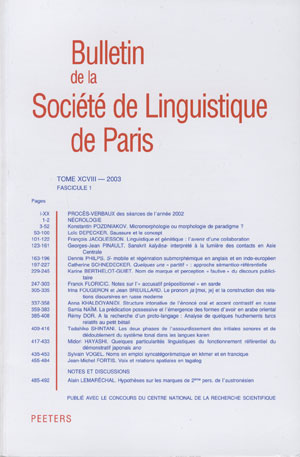 previous article in this issue previous article in this issue | next article in this issue  |

Preview first page |
Document Details : Title: Approche de la déclinaison des substantifs en ancien français Subtitle: De Moignet à Skårup (lecture critique et suggestions) Author(s): CHAMBON, Jean-Pierre , DAVIDSDOTTIR, Rosa Journal: Bulletin de la Société de Linguistique de Paris Volume: 102 Issue: 1 Date: 2007 Pages: 173-192 DOI: 10.2143/BSL.102.1.2028203 Abstract : Les apories mises au jour par la lecture critique de deux travaux classiques émanant d’excellents linguistes (Moignet 1976, Skårup 1994) conduisent à s’interroger sur le traitement que les descriptions de l’ancien français réservent à la déclinaison bicasuelle. Dans la ligne d’une contribution récente consacrée à l’ancien occitan (Chambon 2003) et en utilisant les apports de Stanovaïa (1993), les auteurs proposent, afin de mieux rendre compte de la réalité des usages observables, un modèle descriptif assoupli. Ils suggèrent d’appréhender la flexion substantivale de l’ancien français de manière scalaire, en faisant toute leur part aux faits de variation libre, et se dégageant de la notion «déclinaison», notion piégée non seulement par ses a priori historisants, mais aussi par son caractère sournoisement normatif. The aporias brought to light by the critical reading of two classic works by eminent linguists (Moignet 1976, Skårup 1994) lead to the question of how the double case declension in Old French is described. Following the guidelines set by a recent work on Old Occitan (Chambon 2003) and using the contributions of Stanovaïa (1993), the authors, in order to provide a more accurate account of observed usage, propose a more supple descriptive model. They suggest that noun declensions in Old French should be understood in a scalar manner, highlighting the phenomenon of free variation and setting aside the notion of «declension», a notion misleading not only because of its historical assumptions but also because of its surreptitiously normative character. Erfi∂leikarnir, sem koma í ljós vi∂ gagnrýninn lestur á tveimur klassískum verkum eftir framúrskarandi málvísindamenn (Moignet 1976, Skårup 1994), beina athyglinni a∂ ∫því hvernig svokalla∂ri tveggja falla beygingu í fornfrönsku er lýst. Höfundarnir, sem sty∂jast vi∂ nýlega grein um forn-okksítönsku (Chambon 2003) og notast vi∂ framlag Stanovaïa (1993), leggja til sveigjanlegra form til a∂ lýsa beygingu í fornfrönsku í samræmi vi∂ notkun hennar. þeir leggja fram þá tillögu a∂ nafnor∂abeygingu í fornfrönsku sé lýst á stigbundinn hátt, og a∂ áherslan sé lög∂ á frjálsa dreifingu og a∂ hugtaki∂ «beyging» sé lagt til hli∂ar þar sem þa∂ sé misvísandi, ekki einungis vegna sögulegra fyrirframhugmynda, heldur einnig vegna laumulegra stö∂lunaráhrifa. |
|


